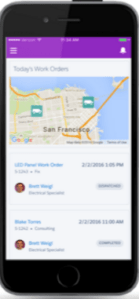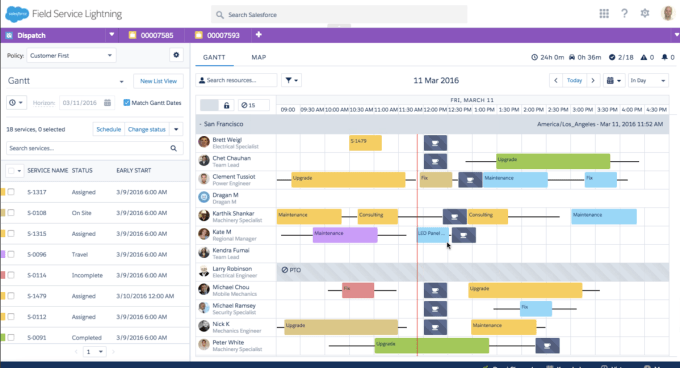Salesforce has its fingers in many pies when it comes to tracking customers, customer service and marketing, but until now it left field service to third parties like ServiceMax. That changed today when the cloud giant announced a new field service product they have dubbed Field Service Lightning.
Salesforce licensed parts of their new solution from ClickSoftware for hard bits like scheduling and optimization, then built the entire solution on top of Service Cloud.
Until now, calls have come into customer service and have been processed in Service Cloud. While there is a connection to the customer record to let sales see when the customer is having issues, there has been no direct way to connect this information to people out in the field; Salesforce wanted to close this gap.
“It’s about connecting phone to field,” Bobby Amezaga, senior director of product marketing for Salesforce Service Cloud told TechCrunch.
While that may be a nice marketing buzz phrase, customers do call in, and if there is a problem that requires service it can then move from the customer service rep to a dispatcher to the repair person in the field in one smooth pass within the Salesforce platform, thanks to this new product. It also removes the problem of moving between software packages to make it happen, Amezaga explained.
In fact he said, they pushed out this product because customers have been requesting a field service component inside Salesforce.
“Our customers are one of the main reasons we launched this. Customers have been asking for a field service solution. There is power in the platform and we wanted to extend this into the field,” he said.
There was also the matter of the competitive landscape. While there are cloud service solutions out there like ServiceMax, other key competitors like Microsoft and Oracle have entered this market recently and Salesforce saw this as a significant missing piece, according to Ian Jacobs an analyst who covers this space for Forrester.
“There are several reasons for Salesforce to jump into this space. The obvious one: they are in a competitive tit-for-tat with Microsoft and Oracle who have both acquired their way into the market. But there are actual benefits to companies of combining field service and customer service on a single platform: better handoff between contact centers, dispatch, and field workers; connecting field service to cases opened in Service Cloud; and a better ability to create a holistic service process,” he said.
How it works
 A customer service rep working in Service Cloud takes a call. She starts a service request and it pulls all the relevant information from the customer record automatically. Then ClickSoftware comes into play with intelligent scheduling, based on rules the customer defines.
A customer service rep working in Service Cloud takes a call. She starts a service request and it pulls all the relevant information from the customer record automatically. Then ClickSoftware comes into play with intelligent scheduling, based on rules the customer defines.
It could look for the closest field service tech or it could look for one that is most skilled at solving a particular problem. It could take into account factors like location, size of the customer and priority as defined by the customer service rep.
Once the call is scheduled, the field service coordinator can view all the appointments in a Gantt chart or on a map and communicate directly with the reps via text message, if needed.
As for the field service person, they have a tablet or smartphone application, which directs them to the next assignment. They can see the entire customer record and have a full understanding of the problem before they walk in. They can check in at arrival, check out when they leave and update the customer record as needed, all from their mobile app.

Photo Credit: Salesforce.com
It’s all coordinated and the record is updated automatically across the entire platform. Everyone can see the interactions with the customer whether purchases, customer service calls or service calls, regardless of the role — salesperson, customer service rep or field service rep.
Look Ma, no beta
The company took the unusual step of releasing the new field service product without a pilot or beta testing period, instead going straight to market. The lack of a pilot did not escape the notice of Forrester’s Jacobs.
“The no pilot or beta was a big surprise to me. But the growth in the subscription model across all sorts of industries (HVAC companies offering cold air as a service, for example) dramatically elevates the importance of field service in the B2B world, and the explosion of home automation and ‘smart’ appliances does the same for the B2C realm,” Jacobs told TechCrunch.
While Amezega didn’t want to get into any detail about how long it took to develop the field service piece, he did say that using ClickSoftware expedited the development process and made it easier to push the product directly to market without testing it first.
